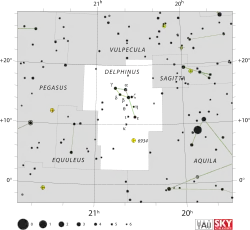Iota Delphini
Iota Delphini (ι Del, ι Delphini) is a star in the constellation Delphinus. It has an apparent magnitude of about 5.4, meaning that it is just barely visible to the naked eye. Based upon parallax measurements made by the Hipparcos spacecraft, this star is around 177 light years away from the Sun.[1]

| |
| Observation data Epoch J2000 Equinox J2000 | |
|---|---|
| Constellation | Delphinus |
| Right ascension | 20h 37m 49.11939s[1] |
| Declination | +11° 22′ 39.6356″[1] |
| Apparent magnitude (V) | 5.428[2] |
| Characteristics | |
| Spectral type | A1IV[2] |
| U−B color index | +0.035[3] |
| B−V color index | +0.035[3] |
| Astrometry | |
| Radial velocity (Rv) | -3.9[2] km/s |
| Proper motion (μ) | RA: 39.15[1] mas/yr Dec.: -8.26[1] mas/yr |
| Parallax (π) | 17.26 ± 0.33[1] mas |
| Distance | 189 ± 4 ly (58 ± 1 pc) |
| Absolute magnitude (MV) | 1.62[4] |
| Orbit[5] | |
| Period (P) | 11.039 days |
| Eccentricity (e) | 0.23 |
| Periastron epoch (T) | 2422139.862 |
| Argument of periastron (ω) (secondary) | 61.8° |
| Semi-amplitude (K1) (primary) | 26.0 km/s |
| Details | |
| Surface gravity (log g) | 4.29[4] cgs |
| Temperature | 9301[4] K |
| Other designations | |
| Database references | |
| SIMBAD | data |
Iota Delphini's spectral type is A1IV, meaning it is an A-type subgiant.[6] Observations of the star's spectrum reveal a periodic Doppler shift. This means that Iota Delphini is a spectroscopic binary with a period of 11 days and an eccentricity of 0.23.[5] However, almost no information is known about the companion star.
Iota Delphini appears to be an Am star,[4] also known as a metallic-line star. These types of stars have spectra indicating varying amounts of metals, like iron.[7] Observations of Iota Delphini's spectrum have showed lower amounts of calcium and higher amounts of iron than usual.[4]
References
- van Leeuwen, F. (2007). "Validation of the new Hipparcos reduction". Astronomy and Astrophysics. 474 (2): 653–664. arXiv:0708.1752. Bibcode:2007A&A...474..653V. doi:10.1051/0004-6361:20078357.
- "iot Del". SIMBAD. Centre de données astronomiques de Strasbourg. Retrieved 15 January 2016.
- Mermilliod, J.-C. (1986). "Compilation of Eggen's UBV data, transformed to UBV (unpublished)". Bibcode:1986EgUBV........0M. Cite journal requires
|journal=(help) - "Abundance analysis of Am binaries and search for tidally driven abundance anomalies - III. HD 116657, HD 138213, HD 155375, HD 159560, HD 196544 and HD 204188". Monthly Notices of the Royal Astronomical Society. 420 (2): 1207–1216. 2012. arXiv:1111.0978. Bibcode:2012MNRAS.420.1207S. doi:10.1111/j.1365-2966.2011.20108.x.
- Pourbaix, D.; et al. (2004). "SB9: The ninth catalogue of spectroscopic binary orbits". Astronomy and Astrophysics. 424 (2): 727. arXiv:astro-ph/0406573. Bibcode:2004A&A...424..727P. doi:10.1051/0004-6361:20041213.
- Allen, J. S. "The Classification of Stellar Spectra". UCL Department of Physics and Astronomy: Astrophysics Group. Retrieved 1 January 2014.
- Am star, The Internet Encyclopedia of Science, David Darling. Accessed on line August 14, 2008.